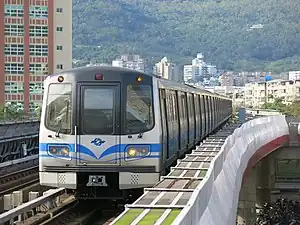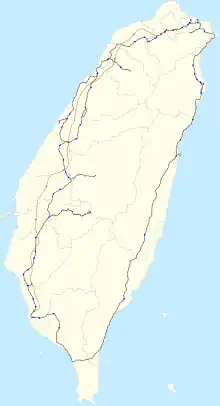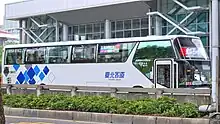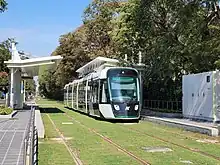Transportation in Taiwan
The Ministry of Transportation and Communications governs transportation in Taiwan.

Land transport

Roads
- Total length: 41,475 km (2009)
- National highway: 901 km
- Provincial highway: 4,680 km
- Highways: 20,947 km (including 872 km of freeways)
- Urban roads: 16,395, km
Rail

Total: 1,580 km (2009) (all on the island of Taiwan)
- Taiwan Railways Administration: 1,097 km of 1,067 mm (3 ft 6 in) gauge
- Taiwan High Speed Rail: 354 km of 1,435 mm (4 ft 8+1⁄2 in) gauge
- Kaohsiung Mass Rapid Transit: 51.8 km of 1,435 mm (4 ft 8+1⁄2 in) gauge
- Taipei Metro: 131.1 km of 1,435 mm (4 ft 8+1⁄2 in) gauge
- Taoyuan Metro: 51.03 km of 1,435 mm (4 ft 8+1⁄2 in) gauge
- Taiwan Sugar Corporation: 240 km of 762 mm (2 ft 6 in) gauge
- Forestry Bureau: 86 km of 762 mm (2 ft 6 in) gauge

High-speed rail
The Taiwan High Speed Rail (THSR) commenced operations on 5 January 2007, after some delays in 2006. The THSR connects Taipei City in the northeast of the island of Taiwan to Kaohsiung City in the southwest. The journey time is about 90 minutes compared to ~3 hours by conventional rail. 30 Shinkansen Class 700T sets are running on the 345 km high-speed line, with station stops at Taipei Main Station, Banqiao, Taoyuan, Hsinchu, Taichung, Chiayi, Tainan and Zuoying near Kaohsiung. Four additional stations have been opened: Nangang in eastern Taipei, Miaoli, Changhua and Yunlin. In 2008 THSR increased the number of trains to 88 per day, each way.
The Shinkansen 700T is similar to the Japanese 700 Nozomi. It operates in 12 car sets (9 powered, 3 trailers) at a speed limit of 300 km/h over standard gauge 1,435 mm (4 ft 8+1⁄2 in) track. OCS power is 25 kV AC 60 Hz.
Conventional rail
The Taiwan Railways Administration (TRA) is the national conventional passenger railway operator in Taiwan, established on the 5th of March 1948. Railway services began in 1891 between Keelung and Hsinchu under mainland China's Qing Dynasty, with a complete reform intended under the Japanese Colonial Government. This Japanese influence remains in TRA's various operations today, where JR (Japan Railways) tack layout, fare gates, and signage can still be observed.[1] With increased competition from the Taiwan High Speed Rail for long-distance services on the west coast, TRA has begun placing emphases on commuter and tourist services.[2]
Urban transit
There are five urban transit systems in Taiwan: Taipei Metro, New Taipei Metro, Taichung Metro, Taoyuan Metro, and Kaohsiung Metro.
Taipei Metro opened in 1996 and runs on an extensive network of both Multiple Unit for the high-capacity system as well as VAL for the medium-capacity system throughout the metropolitan area of Taipei. The metro system operates 6 lines consisting of 131 stations.[3]
The Taoyuan Metro is a metro system with one operational line, one in construction, and one in planning. (Airport MRT, green, brown).[4] The Airport MRT serves Taoyuan, Taipei and New Taipei after it opened in March 2017.
Taichung Metro officially began operation on April 25, 2021 with its Green Line opening. In addition to Taichung, the network will also serve the Changhua and Nantou counties. The metro will start off with 3 main lines (green, blue, and orange), with four other lines planned.[5]
Buses
Various conventional urban and intercity bus operators conduct services in Taipei and other major cities. Some of the most notable players include Taipei Bus (台北客運) and Capitol Bus (首都客運).[6]
Taichung and Chiayi BRT
Taichung's BRT (Bus Rapid Transit) was the first BRT system in Taiwan, spanning 17.1 kilometres (10.6 mi) from Taichung TRA Station to Providence University via the Taiwan Boulevard, containing 21 dedicated right-of-way stations. This line was shut down and converted to a dedicated bus lane on July 8th, 2015.[7]
Chiayi's Bus Rapid Transit system remains in service,[8] connecting Chiayi High Speed Rail station to downtown Chiayi City via Chiayi County. It uses dedicated bus lanes and GPS-controlled traffic signals to speed up commutes between terminals.
Air transport
Airports
During the global COVID-19 pandemic traffic at Taiwan’s large international airports fell sharply while traffic to smaller domestic airports increased as a result of a surge in domestic tourism.[9]
Total: 40
Length of runways:
Airlines
Total: 7
Heliports
Total: 31 (2013)[10]
Sea transport
Ports
Major ports: Keelung,Kaohsiung , Taichung, Hualien
Other ports: Anping, Su'ao, Taipei
Merchant marine:
112 ships (1,000 GT or over) totaling 3,827,173 GT/6,121,877 tonnes deadweight (DWT) (2010)
ships by type:
- Bulk 35
- Cargo 20
- Chemical tanker 1
- Container 31
- Petroleum tanker 12
- Passenger/cargo 4
- Refrigerated cargo 7
- Roll on/roll off 2
Pipelines
As of 2013, Taiwan maintains the following pipelines[11]
- Condensate 25 km
- Gas 802 km
- Oil 241 km
See also
References
- "What's In a Name?—The Unexpected Charms of Japanese-Era Train Stations". New Southbound Policy. Retrieved 2023-09-08.
- "New EMU900 trains for Taiwan to increase capacity and improve comfort". Global Railway Review. Retrieved 2023-09-08.
- "Taipei Metro Networks and Systems". Taipei City Government. Archived from the original on 2013-10-21. Retrieved 2014-01-01.
- "Introduction to Airport MRT". Office of Rapid Transit Systems, Taoyuan. Retrieved 2016-12-28.
- "Taichung Mass Rapid Transit System". Taichung City Government. Retrieved 2014-01-01.
- "City Transportation". New Taipei City Travel. Retrieved 2023-09-08.
- "Environmental Impact Assessment: Taiwan's mission possible: get more people on buses - Taipei Times". www.taipeitimes.com. 2021-06-23. Retrieved 2023-09-08.
- "Transportation". Fulbright Taiwan ETA Program. Retrieved 2023-09-08.
- Strong, Matthew (2 February 2021). "Airports on small Taiwanese islands show growth for 2020". www.taiwannews.com.tw. Retrieved 2 February 2021.
- "CIA World Factbook". August 2023.
- "The World Factbook". Central Intelligence Agency. Retrieved 1 January 2014.

